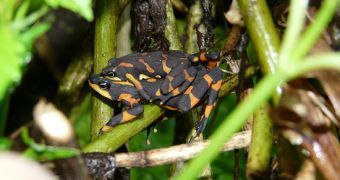A toad species believed to have been extinct for nearly two decades has resurfaced in Costa Rica. Thus, wildlife researchers now say that a highland forest in this country is presently home to a breeding population of these so-called Halloween frogs.
This means that the species is no longer extinct, but “merely” critically endangered.
Writing in a recent issue of the journal Amphibia-Reptilia, specialists detail that, back in the 1980s, a chytrid fungus caused the harlequin toad population in Costa Rica to plummet.
Specifically, out of the 100 such frogs documented by researchers in this part of the world, just one specimen remained. Hence the fact that in 1996, specialists found themselves left with no choice except list the Atelopus varius as an extinct species.
Mongabay tells us that a small population of Halloween frogs was found in southwestern Costa Rica in 2004, but that this population was too small for researchers to take the harlequin toad off the extinct species list.
Fast forward a few years, and another population was discovered within the premises of the La Amistad Biosphere Reserve. This time, specialists documented some 200 frogs, and even found evidence of breeding behavior.
Researchers joke and say that this discovery just goes to prove that Atelopus varius could be labeled a “Lazarus species,” i.e. a species classified as extinct that later makes a surprising comeback.
The wildlife researchers who helped take the harlequin toad off the extinct species list suspect that several other species thought to have fallen off the biodiversity map are also hiding in remote areas, waiting to be rediscovered.
“Our findings fit into the emerging theory that species which have been presumed extinct are beginning to be re-discovered in Costa Rica and elsewhere,” the researchers reportedly write in their paper.
“After severe declines, often to where zero individuals are detected in the wild, several frog species have been re-discovered in areas of Costa Rica with previous records of chytrid, as well as in areas not sampled previously,” they add.

 14 DAY TRIAL //
14 DAY TRIAL //